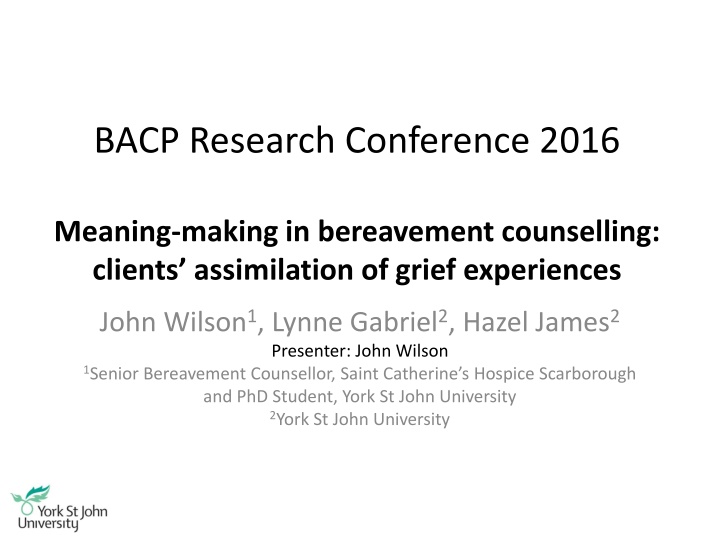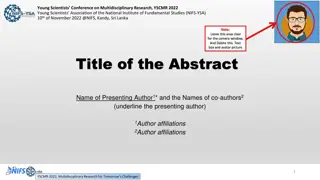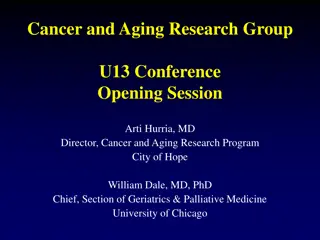
Understanding Meaning-making in Bereavement Counselling
Explore the process of meaning-making in bereavement counselling, where individuals assimilate grief experiences to restore equilibrium after loss. Discover theories and therapeutic approaches that aid clients in adapting to change through articulating their personal narratives.
Download Presentation

Please find below an Image/Link to download the presentation.
The content on the website is provided AS IS for your information and personal use only. It may not be sold, licensed, or shared on other websites without obtaining consent from the author. If you encounter any issues during the download, it is possible that the publisher has removed the file from their server.
You are allowed to download the files provided on this website for personal or commercial use, subject to the condition that they are used lawfully. All files are the property of their respective owners.
The content on the website is provided AS IS for your information and personal use only. It may not be sold, licensed, or shared on other websites without obtaining consent from the author.
E N D
Presentation Transcript
BACP Research Conference 2016 Meaning-making in bereavement counselling: clients assimilation of grief experiences John Wilson1, Lynne Gabriel2, Hazel James2 Presenter: John Wilson 1Senior Bereavement Counsellor, Saint Catherine s Hospice Scarborough and PhD Student, York St John University 2York St John University
Our testable theory Bereavement disrupts physical and emotional equilibrium. The greater the number of complicating factors, the greater the disruption. Grief is the process by which a human restores disrupted equilibrium. She/he attempts this by making sense of the complications she/he faces. The process is one of adaptation to change. The process is observable.
Our testable theory Bereavement disrupts physical and emotional equilibrium. The greater the number of complicating factors, the greater the disruption. Grief is the process by which a human restores disrupted equilibrium. She attempts this by making sense of the complications she faces. The process is one of adaptation to change. The process is observable
Observing the process The process is observable. Constructivist Psychotherapy: George Kelly (1963), Robert Neimeyer (2009). The assimilation and accommodation of schemas: (Piaget, 1952), (Janoff-Bulman, 1992), (Neimeyer, 2009), (Stiles 1999, 1990).
Articulating the theory Each human constructs a personal reality of the world that serves to ensure biological survival. From early childhood the individual constantly tells and retells her own story in the construction of a self-narrative (Neimeyer et al., 2002). When we experience a loss or a traumatic event such as bereavement, this narrative is disrupted and new understanding must be accommodated in a revised version (Attig, 2001, 2011).
Articulating the theory Grief counselling can offer an empathic engagement with the client s disequilibrium of lost attachment which purposefully facilitates the client s relearning of this disrupted personal world. Changes to the self-narrative of grief will be articulated in the therapeutic dyad, both in conversation with the counsellor and conversation with the self.
The search for a research tool The Assimilation of Problematic Experiences Scale APES (Stiles 1999). It involves listening to clients. Therapeutic change is observed against a scale. The client is viewed as a community of voices (Stiles 1999, p.1).
The Assimilation of Problematic Experiences Scale 8 point descriptive sequence: 0 Warded off/ dissociated Client is unaware of the problem; the problematic voice is silent. Affect may be minimal, reflecting successful avoidance. Client prefers not to think about the experience. Problematic voices emerge in response to therapeutic interventions or external circumstances and are suppressed or avoided. Affect involves unfocused negative feelings: their connection with the content may be unclear. Client is aware of a problematic experience but cannot formulate the problem clearly. Problematic voice emerges into sustained awareness. Affect includes acute psychological pain or panic associated with the problematic material. 1 Unwanted thoughts 2 Vague awareness/ emergence
The Assimilation of Problematic Experiences Scale 8 point descriptive sequence: 3 Problem statement/ clarification Content includes a clear statement of a problem something that can be worked on, Opposing voices are differentiated and can talk to each other. Affect is manageable, not panicky. The problematic experience is formulated and understood in some way. Voices reach an understanding with each other (a meaning bridge) . Affect may be mixed, with some unpleasant recognition but also some pleasant surprise. The understanding is used to work on a problem. Voices work together to address problems of living. Affective tone is positive, optimistic. 4 Understandi ng/insight 5 Application/ working through
The Assimilation of Problematic Experiences Scale 8 point descriptive sequence: 6 Problem solution Client achieves a successful solution for a specific problem. Voices work together to address problems of living. Affect is positive, satisfied. Client automatically generalizes solutions; voices are integrated, serving as resources in new situations. Affect is positive or neutral (i.e. this is no longer something to get excited about). 7 Mastery
APES for grief Wilson, J. (2011). The assimilation of problematic experiences sequence: An approach to evidence-based practice in bereavement counseling. Journal of social work in end-of-life & palliative care, 7(4), 350-362.
Methodology Case studies were compared through a theory-building approach (Stiles, 2007, McLeod, 2010) and through adopting replication logic (Yin, 2013). The study maintained a pluralistic approach which addressed both the reality of observer bias and the positivist reality of the observations. We have named this Cautious positivism (Wilson, Gabriel & James, 2014).
Assimilation analysis Sections of each client s transcript were matched against the APES scale. For example: Sophie recognises that she sometimes feels guilty if she has a night out with friends, and this can lead to her avoiding some social situations. APES 3 Problem statement/ clarification: Content includes a clear statement of a problem something that can be worked on, Opposing voices are differentiated and can talk to each other. Affect is manageable, not panicky.
Triangulating the results Each client invited to review the completed case study and discuss whether they regarded this as a valid record of events. Reluctance. Only Sam did this. Enrolled a team of experienced bereavement counsellors to listen to extracts and reach a consensus on the APES scale for each extract. High level of consensus on Tony s case study (7 counsellors).
Session Group consensus Researcher Assessment APES 2.5 APES 3.0 Session 2 APES 2.0 APES 3.0 Session 4 APES 3.0 APES 3.5 Session 5 Strongly towards APES 4.0 APES 4.0 Session 9 APES 4.0 APES 4.5 Session 10 APES 4.0 APES 4.5 Session 11 Between APES 4 & 5 APES 4.5 Session 23 Well into APES 5.0 APES 6.5 Session 24 Cusp of APES 6.0 APES 6.7 Session 37 APES 6.0 towards 7 APES 7.0
Confidence in the results On the basis of the consensus exercise, APES was adapted for grief: The Assimilation of Grief Experiences Sequence, AGES is based on the transcripts of the 5 case studies. AGES differs from APES in that initial avoidance and later on periodic avoidance is construed as helpful rather than maladaptive.
Assimilation of Grief Experiences Scale, AGES Managing the pain of grief Reminders which intensify the grief are avoided. Some clients manage this by keeping busy . The client is often unaware of the full extent of her grief, although it is obvious to friends and family, who may begin to worry and suggest professional help. Circumstances Client shows extreme difficulty in talking about the circumstances of the death. If pressed to do so, the account is short and brief. The client avoids reminders, e.g. music, photographs etc. As she approaches stage 2 she becomes more willing to talk about the events with others, but does not easily raise the topic. She may become upset and tearful. Relationship to the deceased Client clings to pretence that the loved-one is still alive. They talk as if the loved one was still there, e.g. greeting them on returning home from being out. The house remains unchanged, including the possessions of the deceased. Places associated with the deceased are often avoided. The client may express difficulties with being away from home, because they feel they are abandoning their loved one. Client may cry out in anguish, calling to the deceased. There may be regular, even daily visits to the grave or place where ashes are scattered. The client sometimes displays searching behaviour which may be desperate and distressing. Stage 1: Unwanted thoughts
Assimilation of Grief Experiences Scale, AGES Managing the pain of grief The client has learnt to oscillate comfortably between spending time dwelling on the loss and engaging in restorative activities. Thus periods of grief avoidance become helpful. The client becomes more accepting of her up and down moods. Feeling down becomes less frightening. Feelings of guilt at moving on become successfully managed and sadness is no longer identified as essential for continued love loyalty towards the deceased. The interludes of grief and sadness become accepted and integrated into daily life: That is how it is, and how it will be for some time yet. This stage can be summed up as Keep calm and carry on . Circumstances Client begins to reach a new understanding and acceptance. She articulates, perhaps with prompts and open questioning, that she can make sense of the circumstances surrounding the death. She may articulate a religious or spiritual meaning in which the client says they find comfort. Examples include, She is at peace now and He died so as to be there in heaven for his grandson . At this stage there is often an acceptance that grief will be here to stay for a while, but pain is being replaced by sadness. Relationship to the deceased Visits to significant places, e.g. the graveside, become less importance and have less significance. Client is increasingly comfortable about being happy in relation to the deceased. Relationship to the deceased is negotiated and renegotiated towards a symbolic form. Magical expectations that they can ever physically return become increasingly rare and fleeting. Client can find meaning in the life of the deceased, including shared experiences. Examples of things the client says include, He had a good life , We did so much together and She achieved so much in her life . Stage 5: Application/ working through
Triangulating the results To test the reliability of AGES, 18 counsellors rated 20 randomly selected statements made by Sophie against the scale. Reliability was excellent: Cronbach s alpha 0.9.
Principal findings Clients reach a problem solution once they can: i) accept the reality of the death, ii) make sense of the death, iii) acquire and practice coping strategies. (Distraction and avoidance can play an important part in this), iv) accept that for a time, sadness will be as good as it gets , v) find meaning in a life without the deceased, vi) anticipate a positive future . This may include an individualised and creative continuing bond with the deceased: moving forward in a continuing symbolic relationship.
Limitations Whilst five case studies are inadequate to draw firm conclusions, a theory-building methodology allows each new case study to add a small degree of confidence to previous findings.
Implications A reliable and valid Assimilation of Grief scale would provide clinical evidence of psychological change and could be developed into an outcome questionnaire. Bereavement work may be more effective if counsellors are trained to stimulate and foster assimilation of the client s post bereavement world.
Thank you for listening Questions? john@moorsidecounselling.co.uk john.wilson3@yorksj.ac.uk





















